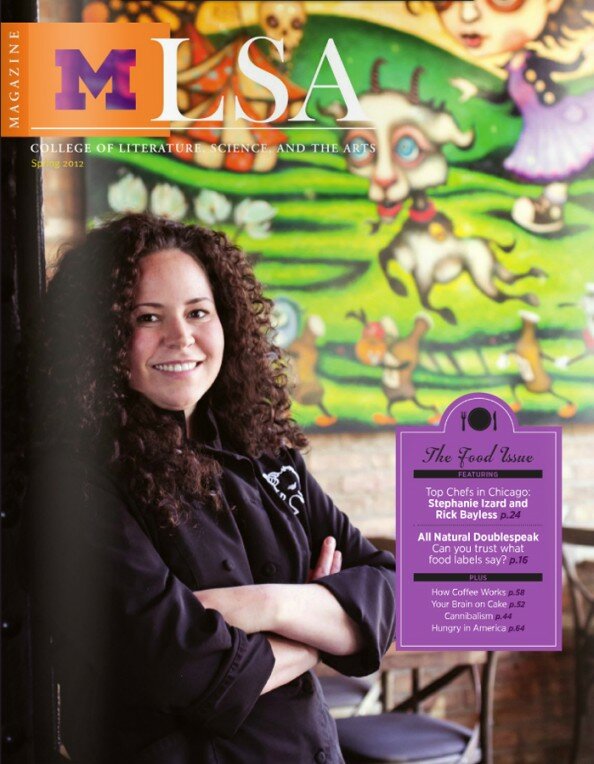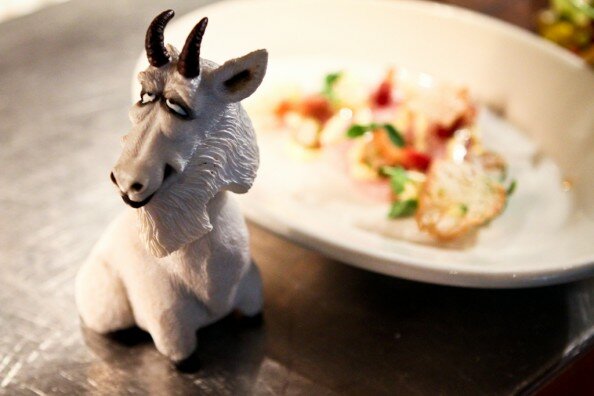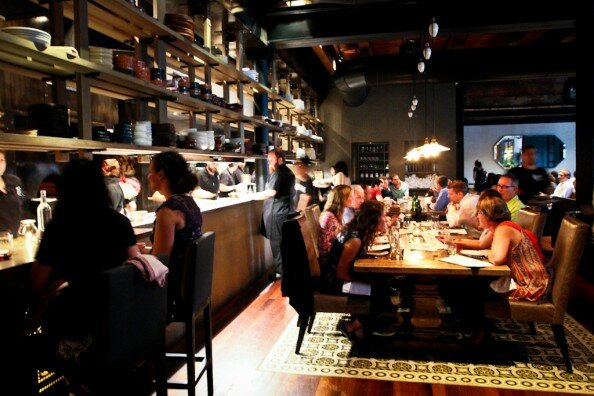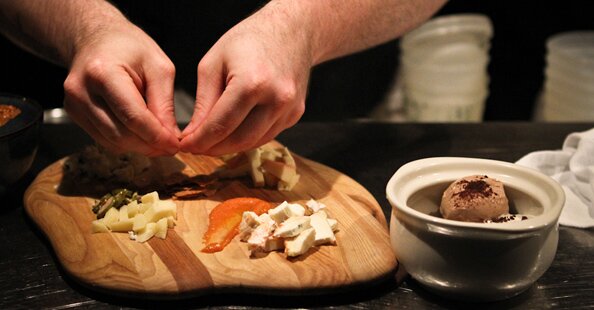
Monthly Archives: June 2012
Gourmet Underground Detroit's content archives are organized by date and catalog the aggregated content of our Features pages as well as our blog.
Domaine Abbatucci
 During dinner with some friends on my patio last night, I opened a bottle of Corsican wine about which I knew next to nothing. It really illustrates one of the things I love about wine, which is that there’s always something new to learn. Whether it be a comparative tasting of different vintages or chemistry or culture or tracing the lineages of grapes, the dive into a wine’s origins can be an absolutely endless journey.
During dinner with some friends on my patio last night, I opened a bottle of Corsican wine about which I knew next to nothing. It really illustrates one of the things I love about wine, which is that there’s always something new to learn. Whether it be a comparative tasting of different vintages or chemistry or culture or tracing the lineages of grapes, the dive into a wine’s origins can be an absolutely endless journey.
Cuvée Collection “Diplomate d’Empire, Il Cavalière” from Domaine Abbatucci not only occupied a portion of the conversation last night, it has occupied my entire morning. Composed of 37% Vermentinu, 20% Rossala Bianca, 19% Biancu Gentile, 14% Genovese, and 10% Brustiano (from the Kermit Lynch website), the cepage was so foreign to me that I’ve been obsessing about figuring out what the hell all of these grapes actually are.
The wine itself was remarkably dense and rich: Very floral, fleshy nose with melon/white fruit aromas. Sweet on the palate, but not flabby at all. I tasted the fruit first and foremost, but there’s an inherent mineral-driven acidity/structure to it. Viscous and oily texture, it’s got a very serious weight to it and a finish that lingers. It’s really very interesting, luscious stuff. Very distinct and dare I even say unique. I wish I’d gotten a second bottle, because for all of its loveliness, I felt like it had more to offer had I given it a bit more time to breathe.
After having my mind blown, I decided to investigate the winery and those odd grapes a bit.
First, the winemaker has a fascinating history. His father is responsible for saving tons of native Corsican grapes, and they’re directly descended from Napoleon Bonaparte. This Cuvée Collection set of wines are all named after people who were involved in Napoleon’s life: So the Diplomate in question is actually a childhood friend of Napoleon who fought with him at the Battle of Waterloo. The details are outlined on Lynch’s website.
The grapes are equally interesting. Having compared the importer’s notes and the Domaine’s own website, I realized that while Lynch was listing the Corsican names for the grapes, they’re far more commonly known by their Italian names (or the synonymous French names). Vermantinu was obviously Vermantino, prized for its aromatic qualities. Rossala Bianca is, in Italy, Rossola Bianca, and according to a book by Oz Clarke, it’s synonymous with Ugni Blanc from France, most notable for its use in making cognac (where grapes that yield high acid are prized for the flavors it yields through distillation). Of course, Ugni Blanc is also, I believe, know as Trebbiano in Italy. Say what?
So the morning got off to a start that was, to put it bluntly, confusing as fuck.
I kept digging, though, and I could find nothing on Bianco Gentile except some references to other Corsican wines where it was consistently referred to as one of the “lost” varieties that’s recently been reclaimed. As I mentioned earlier, it’s the Abbatucci winemaker’s father who took it upon himself to wander the Corsican countryside and preserve grapes like Bianco Gentile from what would have otherwise been extinction in the 1960s.
I couldn’t find much on Genovese other than some references to a “Bianchetta Genovese,” which is ostensibly a non-descript Italian grape called Albarola according to Wikipedia and a few blogs. The subtle distinctions aren’t really all that important, I suppose, but while it’s known for its plantings in northern Italy, this Albarola simply must be at least a little different in Corsica (assuming its even related). The evolution of distinct ecosystems and how that impacts the resulting grapes is every bit as interesting to me as the food and cultural components to how a particular wine has evolved over time.
Similarly, do a Google search on the last grape, Brustiano, and about a million websites will tell you that it’s synonymous with Vermantino, but clearly the winemaker finds something different since he lists both Vermantino and Brustiano as components to his wine.
Regardless, this combination of mostly soft, semi-sweet grapes and Ugni Blanc created a drink that’s quite profound. Naturally, it’s available in limited quantities. The winemaker makes a number of wines, but the “Cuvée Collection” series are all from a single plot of these heirloom, indigenous grape varieties, farmed biodynamically (down to the weird ass moon cycle rituals) with low yields, and so on.
So its rarity and relatively lofty price tag are easy to understand.
This bottle was recommended to me by Elie Boudt at Elie Wine Company in Royal Oak. There are only two cases, so if you’re interested, get there soon. I drank it along side grilled halibut and veggies as well as a wheat berry salad with a distinctly provençal twist. Pretty much perfect.
Chicago Road Trip
 In spring 2012, my alma mater, the College of Literature, Science, and the Arts (LSA) at the University of Michigan, printed two pieces I wrote after interviewing Chicago chefs and U-M alumni Rick Bayless and Stephanie Izard. They’re both being re-published here with permission of LSA Magazine.
In spring 2012, my alma mater, the College of Literature, Science, and the Arts (LSA) at the University of Michigan, printed two pieces I wrote after interviewing Chicago chefs and U-M alumni Rick Bayless and Stephanie Izard. They’re both being re-published here with permission of LSA Magazine.
If you have but one day in Chicago this summer, I can think of no finer way to spend it than lunching at Bayless’ XOCO and having dinner at Izard’s Girl and the Goat.
* * * * *
After graduating from the College of LSA, chef Rick Bayless spent years in Mexico studying the language, the people, the food. The knowledge he brought back to the United States helped change the landscape of cuisine as we know it. The linguistics major-turned-culinary-giant gave us a seat at the table to discuss his salad days – then and now.
Chef Rick Bayless (’75, M.A.) is every bit as infatuated with Mexican cuisine today as he was in 1987 when he opened Frontera Grill in Chicago and released his first book, Authentic Mexican: Regional Cooking from the Heart of Mexico. “I can look at something I discovered 30 years ago and understand it now in such an intimate way that I could never have done at the very beginning,” he says. “That sense of deepening discovery is what keeps me going every day.”
A recent winner of Bravo’s television program Top Chef: Masters and an unquestioned legend of Chicago’s now vibrant food scene, Bayless is as big a celebrity chef as anyone in the United States. It’s hard to imagine North Clark Street without his trio of restaurants or store shelves without his salsas, but he didn’t begin his career looking to be famous. Or even to cook.
“I was really interested in the relationship between language and culture,” he says of his college years spent studying Spanish and Latin American culture. After living in Mexico with his family as a teenager, Bayless became an undergraduate at the University of Oklahoma. He spent two summers in an applied linguistics program and learned how to enter communities that lacked a written language, learn and interpret their spoken words, and ultimately understand that culture through their stories.
He followed the program’s director to LSA’s Department of Linguistics, where he began several years of doctoral work. But he found more than just scholarly interests awaiting him in Ann Arbor.
“I fell in with this group of students… we didn’t have any money at all, but we were all super into food,” Bayless recalls. “I didn’t even understand how unique the food community of Ann Arbor was then, but it was centered around the farmers’ market.” He and his friends would buy their fresh ingredients in Kerrytown and at Eastern Market in Detroit, meeting and interacting with farmers, a practice reminiscent of the everyday life he’d experienced in Mexico.
These linguistics students prepared food together regularly, exploring different cuisines from a myriad of cultures. Bayless started catering. He taught local cooking classes. Then he had an epiphany: “I was at least as interested in the relationship between culture and food as I was culture and language.”
That’s when the future James Beard National Chef of the Year stopped work on his dissertation and immersed himself in the food of Mexico.
Throughout the early 1980s, Bayless lived and traveled in Mexico with his wife, Deann Bayless (’71, ’78 M.U.S.), utilizing his academic experience to construct Authentic Mexican. Each recipe was studied using the same research methodology he learned at Michigan: He prepared each dish with three different families or cooks to grasp every nuance, every approach, every ingredient. The result was more than a cookbook; it became a comprehensive look at the cuisine of Mexico as an expression of regional culture as well as an influential guide to a burgeoning American food scene that was slowly awakening from a decade or two of hibernation.

Upon returning to the United States, Bayless found himself in the midst of a dormant food culture dominated by commoditized products and corporate wholesalers – a stark contrast to his childhood.
“I’m a child of the ’60s. I made my first compost pile when I was 16. I made salt-rising bread,” he recalls. “I went with my father to the market in Oklahoma City… and the farmers would bring their stuff and we’d buy from the farmers,” Bayless remembers. “And then, that all went away and it just went to a commercial commodity market. We never had face-to-face contact with the people who were growing our food anymore. And I had a sense of loss about that.”
A do-it-yourselfer raised in a family of restaurateurs living amongst small farmers in Oklahoma, he couldn’t abide the lack of local food he found as he began his culinary career.
So Bayless set out to do things differently. He describes his first experience as a chef engaging Chicago-area farmers: “One of the things I wanted to do was put something local on our menu…. We opened in March, and May is when we have our short, local strawberry season… so I went down to the commercial market…. And they all said, ‘No one would carry those. They’re terrible.’ Well, they’re terrible only if you’re thinking of them as a commodity. They’re phenomenal if you’re thinking of them as flavor.”
Literally laughed out of the market by wholesalers, Rick and Deann drove twice per week to farmer stands outside the city to acquire those local berries for desserts. Beyond the superior flavor, the chef regained a connection to farmers in a way he hadn’t experienced since childhood. And he became increasingly grateful for it.
When Bayless talks about food, he looks and sounds as much like a professor of art history as he does a master of the culinary arts. His conference room at Frontera doubles as a library, its 10-foot walls lined with volumes on every conceivable culinary topic, ranging from French sauces to chocolate to Mexican culture to gardening. And, indeed, he broaches the subject of food as any intellectual might – that is, from every conceivable angle: flavor, art, community engagement, eco-friendliness.
Thus it’s perhaps unsurprising that his consistently calm demeanor elevates to a passionate tone when discussing the interrelated nature of his customers, his farmers, and his food.
“I have always seen restaurants – and I guess it’s because I grew up in a family-style restaurant—as creating community,” he says in describing his family’s approach to business. Along with those childhood trips meeting farmers, the notion of community has shaped his work.
“I’m an accidental organic farming champion,” he notes. “What I learned was that the people that cared most about what they were growing also cared most about the earth…. [Farmers] taught me about the interconnectedness of what I do as a living.” His holistic view of soil’s role in the food he serves his customers has led him to value sustainability. “If it’s local and sustainable, it’s part of that sense of community. It’s not just in putting money in the pocket of the farmer, but it’s protecting our environment that allows us all to thrive.”
Committed past the point of mere rhetoric or marketing, Bayless has maintained a laser-like focus: 25 years since he first ferreted out local strawberries, he has continued to push the boundaries of how local, sustainable food can be used. “The thing about food is that the more you’re around it, the deeper you can go,” he says.
During the late summer, 100 percent of his tomatoes and tomatillos are Chicago-raised. Even Tortas Frontera, his O’Hare Airport-based eatery, lists from where the food is sourced. His Frontera Farmer Foundation raised $180,000 last summer in support of local farms, and he’s a board member at the local Green City Market, the lone Chicago-area market dedicated solely to local, sustainable foods.
“With the strength of our local agricultural system, our food is different, and it allows a uniquely Chicago perspective on traditional Mexican flavor,” he says. So he strives to employ it often, noting that what he serves isn’t always what one might find in Oaxaca or the Yucatan. Rather, he asks himself, “How do you get local flavor on the plate without messing with the traditional soul that you find in Mexican kitchens?”
Bayless grows some of those Mexican-inspired ingredients on Frontera’s eco-friendly rooftop garden and at his own home. The only common ingredient that doesn’t occasionally come from Chicago-area farmers is dried chiles because, as he says, “the flavors just can’t be duplicated, and… we’re into making delicious food.”
In contrast to the many celebrity chefs leaving their hometowns, opening restaurants in Vegas or eating strange foods on cable television for shock value, Bayless’ three primary restaurants and offices are on a single block, and he’s entering the eighth season of Mexico – One Plate at a Time, airing locally in Chicago or on various PBS stations and often costarring his daughter.
When he does leave Chicago, it’s usually to visit other countries to study new cuisine and other cultures, and to enhance the culinary creativity on display at his restaurants.
“You can learn things that reflect back into your food, other techniques, and other ingredients that will open your mind to different flavor possibilities,” he observes. “Anything is open to us as long as it has the spirit of the Mexican kitchen.”
* * * * *
Chef Stephanie Izard has won Top Chef, not to mention a host of awards for her new Chicago restaurant, Girl and the Goat, but her food is neither haughty nor highbrow. Izard studies “common food” and elevates it, with a culinary result that’s like Izard herself – genuine and clever.

Soaked in syrupy lemon dressing, Chef Stephanie Izard’s eggplant is an eyeopening revelation. Eye-opening because it is a dessert; a revelation because it is the perfect acidic counterpoint to other elements on my plate: pork-fat doughnuts, ham streusel, caramelized figs, and a honey yogurt. Soft, crunchy, fatty, sweet, salty, and tart – it is an embodiment of Izard’s “make your whole mouth happy” philosophy.
The meals she prepares under that banner have garnered her and Girl and the Goat – the Chicago restaurant she opened in 2010 – national acclaim. Izard was a celebrity already, having won season four of Bravo’s wildly popular Top Chef, but it’s her work since, as chef and co-owner at the Goat, that have catapulted her to true stardom. Capturing rave reviews from the Chicago Tribune and Saveur magazine as well as a prestigious James Beard nomination, she was named a Food and Wine Best New Chef in 2011.
“If you could see me when I was on stage getting my award for that in New York, I had a gigantic perma-grin the entire time,” she recalls.
That’s hardly surprising: Izard’s a veritable ball of energy, talking fast, laughing a lot, and infusing every inch of her sizeable restaurant with every ounce of her sizeable persona. “I just wanted to take what I love about dining – which is hanging out with friends, usually quite a few drinks—and that’s why this place has a party vibe. Big fun with lots of energy.”
The space fosters that attitude with ample seating and high ceilings that echo with hundreds of voices, and a soundtrack that ranges from Johnny Cash to the Red Hot Chili Peppers to Regina Spektor. The bar is packed with tourists and regulars alike, and the atmosphere spawns conversation from the moment the front door opens.

Seated at the far end of that very bar, I was quickly befriended by a 40-something professional Chicagoan awaiting some friends. Within 45 minutes, I was sharing my cauliflower with pickled peppers and mint – portions at Girl and the Goat are naturally designed for sharing with friends both old and new – and she was sharing her goat chorizo flatbread.
The shareable, approachable food is just as driven by Izard’s demeanor as the palpable friendliness imbued throughout the dining room. Signature dishes like roasted pig face, a dramatically more interesting variation on traditional head cheese, elevate comfort food and ostensibly simple ingredients to haute cuisine, without even a hint of the snobbery that sometimes pervades the restaurant world.
“I’ve been lucky and have eaten at some amazing restaurants,” says Izard, “and I enjoy it, but I don’t enjoy the stuffiness of it.I just don’t think one has to come hand in hand with the other.” She adds, “I’ve definitely always been anti-pretense.”
That attitude is exemplified in her thorough, hands-on approach. Izard doesn’t just prepare a meal; she studies each component of it. Before opening the Goat, she took the time to visit local farms, getting to know the farmers and learning everything from how the animals are treated to how goat cheese is made. “Now [the farmers are] my friends. I call them up, we hang out,” she says. Izard contracts with farms “where we liked the farmers themselves and respect what they’re doing. We only get animals from farms where we know they’re raised properly.”
Her commitment to that depth of understanding extends to every aspect of the restaurant, which includes having an inhouse baker and butcher. She’s explored an interest in beer (the lone piece of art in the restaurant features a girl, a goat, and dancing beer bottles) by visiting Indiana’s Three Floyds Brewing and by actually making beer with Chicago-based Goose Island. “I’ve gotten to brew beer a couple times. I don’t think it’s anything I could do by myself, but it’s really cool to know more about it. And we make our own wine in Walla Walla (Washington). We make our own cheese. I just kind of want to learn how to do everything.”
Izard’s curiosity about food began early at her childhood home in Connecticut, where her parents enjoyed a wide range of cuisine. She earned a sociology degree from LSA in 1998, and if there were any hint at her future, it lay in evenings out with friends.”We would go through and order all these different beers, and I remember [learning] about it and thinking, “this is cool.'”
After graduation, she enrolled in Le Cordon Bleu in Arizona, where she learned the skills that later took her to several acclaimed Chicago establishments before opening her first restaurant, Scylla, in 2006. Despite rave reviews, she opted to close in 2008, not long after which she joined Top Chef. The prize money helped pave the way to her current endeavor.
 From day one, Izard has insisted on staff sharing her excitement for their ingredients, drinks, and food.
From day one, Izard has insisted on staff sharing her excitement for their ingredients, drinks, and food.
“We interviewed over 1,000 people,” she says, “and we’ve interviewed people who worked at some of the best restaurants in the city, and I’m like ‘yeah, you’re a great server, but still, you’re not getting it. You need to have the enthusiasm, and you need to want to make someone feel comfortable as soon as they walk in the door.'”
Izard’s a master at lending that sense of comfort to her patrons: Sitting at the bar, looking toward the kitchen, I could see fans approaching her to say hi or take pictures, which often end up on the restaurant’s website. She’s become widely known for being one of the most sociable “celebrity chefs” in the country, someone who hasn’t changed as a result of her fame.”Even if I’m sick at the store and a fan comes up, I’m still going to talk to them. [Some chefs] get annoyed by people… but someone coming up to you and saying they love you? I mean, that’s pretty nice. Be happy about it.”
That connection with her devotees achieved new heights last summer when Izard launched a fundraiser for Share Our Strength, an organization fighting childhood hunger: “We’re doing these benefit dinners called Supper at Steph’s where I invite eight strangers into my house and cook dinner for them, and my staff said, ‘Seriously, Stephanie, what if they look through your underwear drawer?’ And I’m like, well, they’ll look through my underwear drawer. I don’t care.”
She’s laughing as a cook brings her a spoon covered in ginger dressing destined for the crunchy raw kohlrabi salad. “As long as I’m not in the bathroom, they’re supposed to bring me a taste.”
Izard’s well-known for carrying her upbeat persona and positive demeanor into the kitchen, a place notorious for hot tempers and demeaning attitudes. “I think that my cooks genuinely enjoy coming to work. Of course, they’re often hungover and tired and don’t really want to get here in the morning. But we have fun. We sing and dance all day. Having someone yell at me doesn’t make me want to work harder for them, it makes me want to have them not be around anymore.”
That’s not idle talk. The restaurant’s open kitchen allows patrons to peer inside. “You can see all the cooks smiling and enjoying each other’s company, which I just think is so important. If you’re putting out food that’s supposed to have all this love in it and you’re pissed off, it’s probably not going to taste as good.”
Her cooks must have an awful lot of love, because the lengthy menu is delicious from top to bottom. In her inimitable style, she doesn’t overthink it. “If I try too hard to make new menu items – like, all right, I must make a new fish dish this week, then it never works. So for me, it’s waiting to see if something just hits and something clicks. Like if I walk in the cooler and see some vegetable next to another one, and I’m like, ‘Yeah!'” That revelation explains her cross-cultural influences – for example, Izard’s crudo, an Italian-inspired raw fish dish, puts buttery Pacific hiramasa under bits of pork belly, Peruvian chiles, and caperberries.
That culinary creativity is showcased in Girl in the Kitchen, a book of recipes from her home kitchen released last October. She toured all winter to support the cookbook, while simultaneously planning her version of a classic diner, which she’s calling The Little Goat. She’s constantly busy, but she admits that’s how she likes it. “I’ve always been really driven and want to be as successful as possible. And I’m hoping to retire in 10 years, so I’ve got a lot to do.”

Breaking News: Elitism Runs Rampant in Cocktail Bars!
We’re under siege, folks. Less than a year after the first dedicated cocktail bar opened in the metro Detroit area, elitism and ego-maniacal bartenders are ruining the spirit of the bar. Gone are the good old days of showing up to a bar, having a nice chat, and paying for whiskey with that lone dollar bill you had crammed into your pack of smokes.
Or at least, that’s what Christine Sismondo of Huffington Post is claiming.
I recognize that linking back to their post is exactly what they’re after with these types of trolls, but (a) our tiny ass website isn’t going to make much a difference one way or the other and (b) I hate the obnoxious practice of requiring a login from Facebook or Twitter in order to respond, so I’m going to write up my response (some uneducated folks might call it a “rant” or something) right here instead.
In comparison with cork-sniffing and vintage-cataloguing, quaffing cocktails seemed a lot more fun — and a whole lot less like work. That was 10 years ago, an era when cranberry juice reigned behind the bar, insisting on fresh citrus was considered crazy and the shaken martini was still de rigeur.
I find claims of sweeping elitism from those who, unlike those of us in and around Detroit, have had seemingly regular access to craft cocktails for a decade to be more than a little disingenuous. I wonder if the author went back to drinking nothing but Jack with sour mix and G&Ts for 5 years if she’d feel the same way.
After she gives us quick history of the resurgence of craft cocktails, we get this gem:
As bartenders are downright fetishized for their ability to combine specific spirits, I feel we’re losing some of the spirit of the bar. People are there to have a good time and meet people, not to pray at the altar of the cocktail.
OK, actually, I agree. After all, every moment of every day is all about ME, and the last thing I should do is go out to enjoy something interesting that someone else worked hard to make. Deriving pleasure from eating and drinking the result of someone else’s time and effort is so yesterday. Who cares if it’s a unique drink that I can’t make it at home? Pass the Blueberry Stoli.
Also, I find that I dine out just to fill up and chat with my friends, not to derive any real satisfaction from what I’m eating. I’m not there “to pray at the altar” of the chef, so I’m just going to patronize McDonald’s from now on. Why deal with pretentious servers talking about farmers and shit when I can just have a seat in an uncomfortable plastic booth and shovel food in my face while eking out a little conversation betwixt huge bites?
There are other aspects of fine drinking (as opposed to fine dining) that are less than democratic. Craft cocktail bars aren’t your drop-by-after-work-and-chat-with-Norm kind of places.
Uh, really? In every city I’ve ever been, I’ve made decent pals with the bartenders at the cocktail bars I’ve gone to. And here in Detroit, anyone who thinks Dave, Chuck, Yani, Lucy, John, and Rick at the Sugar House and Sandy, Adrianne, and Jackie from the Oakland aren’t friendly are crazy.
Also, while it is true that I do not in fact know anyone named Norm with whom I can chat at either of those bars (or any of the other bars in Michigan for that matter), I do see someone I know every time I go to them. Granted, most of my friends are lushes, and this isn’t New York with its 800 million people, but whatever.
Why are we trying to de-socialize the emblem of sociability? And then there’s the price. It’s not unusual for a cocktail to run between $12 and $16 these days.
Sounds like she lives in a crappy place with crappy bars. Move to another city, crazy lady. Par example, as the French would say, Detroit’s tres cool, as the French would also say.
Then after you move to Detroit, if you don’t want an elitist bowl of sea urchin foam layered atop gold-infused gin, just order an Old Fashioned at the Sugar House, which is made well and will cost you five whole dollars. Come to think of it, is there a bar in your city where they are forcibly dumping cinnamon bitters and egg whites down customers’ throats and charging 20 bucks? Because that actually would be a problem worth writing about in HuffPo.
But just in case elitism is even a small component, I’m doing my part to fight it — I’m switching back to wine. And the occasional vodka.
Thank goodness! Because first growth Bordeaux and Grey Goose have absolutely no problem with snobbery or exclusivity among those who serve or drink it. Keep on fighting the good fight!
Meanwhile, I’m going to thank my lucky stars that we’re no longer part of the era where our choices were basically a vodka and cran or a Bud Light. If that’s our alternative, I’ll relish a little elitism in my life.